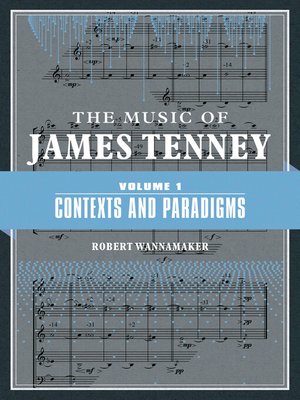
Sign up to save your library
With an OverDrive account, you can save your favorite libraries for at-a-glance information about availability. Find out more about OverDrive accounts.
Find this title in Libby, the library reading app by OverDrive.



Search for a digital library with this title
Title found at these libraries:
| Library Name | Distance |
|---|---|
| Loading... |
Robert Wannamaker's monumental two-volume study explores the influential music and ideas of American composer, theorist, writer, performer, and educator James Tenney. Delving into the whole of Tenney's far-ranging oeuvre, Wannamaker provides in-depth, aurally grounded analyses of works linked to the artist's revolutionary theories of musical form, timbre, and harmonic perception.
Volume 1, Contexts and Paradigms, chronologically surveys Tenney's creative development and output. Wannamaker begins each section with biographical, aesthetic, and technical context that illuminates a distinct period in Tenney's career. From there, he analyzes a small number of pieces that illuminate the concerns, characteristics, and techniques that emerged in Tenney's music during that time. Wannamaker supplements the text with musical examples, graphs, and diagrams while also drawing on unpublished material and newly available primary sources to flesh out each work and the ideas that shaped it.
A landmark in experimental music scholarship, The Music of James Tenney is a first-of-its-kind consideration of the experimental music titan and his work.
|Preface xi
Conventions and Abbreviations xv
1. Introduction 1
1.1. A Summary Chronology 3
1.2. Aesthetic and Methodological Bases: Music in Sound 10
2. Early Works and Influences (1934–59) 18
2.1. Stan Brakhage and Interim (1952) 19
2.2. Manhattan and Meeting Carolee Schneemann 21
2.3. Lionel Nowak, Carl Ruggles, and Charles Ives's Concord Sonata 23
2.4. Seeds (1956/1961) 25
3. Tape Music and "Meta/-Hodos" (1959–61) 31
3.1. Lejaren Hiller and Harry Partch 31
3.2. The University of Illinois Electronic Music Studio 32
3.3. Collage #1 ("Blue Suede") (1961) 34
3.4. "Meta/-Hodos" (1961) 41
4. Computer Music and Ergodicity (1961–64) 48
4.1. Edgard Var se, D'Arcy Thompson, and "Growth to Form" 51
4.2. John Cage, Variety, and Ergodicity 54
4.3. Max Mathews and MUSIC 59
4.4. The Acoustic Correlates of Timbre 62
4.5. Algorithmic Composition 63
4.6. Analog #1 (Noise Study) (1961) 68
4.7. Phases (1963) 76
5. Performance and the Social (1964–68) 83
5.1. Downtown in the 1960s 83
5.2. Tone Roads and an American Experimental Tradition 86
5.3. Fluxus and Friends 89
5.4. Carolee Schneemann, Antonin Artaud, Wilhelm Reich 93
5.5. Choreogram (1964) 97
5.6. Fabric for Che (1967) 101
6. Process and Continuity (1969–71) 110
6.1. Gradual Processes 112
6.2. For Ann (rising) (1969) 118
6.3. Postal Pieces (1965–71) 124
7. Interlude: Harmonic Theory 135
7.1. The Meaning of Harmony 137
7.2. The Harmonic Series 140
7.3. Interval Tolerance and "The Language of Ratios" 144
7.4. A History of Consonance and Dissonance 147
7.5. Roughness and Beating (CDC-5) 148
7.6. Toneness and Harmonicity (CDC-2) 149
7.7. Harmonic Space (CDC-1) 155
7.8. Harmonic Measures and Their Applications 165
8. Canons and the Harmonic Series (1972–79) 169
8.1. The Harmonic-Series Music 170
8.2. Clang (1972) 172
8.3. Spectral CANON for CONLON Nancarrow (1974) 176
8.4. Harmonium #1 (1976) 183
8.5. Three Indigenous Songs (1979) 189
9. Harmonic Spaces (1980–85) 193
9.1. The Harmonic-Space Music 193
9.2. Harmonium #3 (1980) 195
9.3. Bridge (1984) 199
9.4. Koan for String Quartet (1984) 216
10. Transition...







